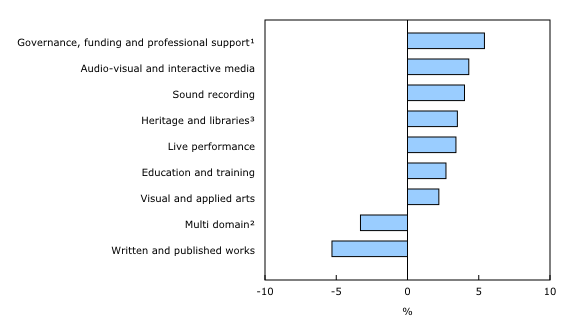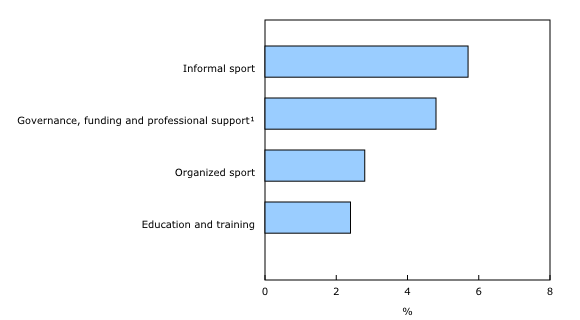Provincial and Territorial Cultural Indicators, 2018
Archived Content
Information identified as archived is provided for reference, research or recordkeeping purposes. It is not subject to the Government of Canada Web Standards and has not been altered or updated since it was archived. Please "contact us" to request a format other than those available.
Released: 2020-10-22
Nominal gross domestic product (GDP) of the culture and sport sectors increased across most of the country in 2018, rising by 2.3% to $61.9 billion or 3.0% of the total economy. This compares with growth of 4.0% for the total economy.
Culture GDP contribution share changing
Interactive media (+6.9%) and design (+3.5%) continued to exemplify the evolving culture sector in 2018. They have represented a progressively larger share since 2010, amounting to 17.4% of culture GDP in 2018 compared with 12.6% in 2010. The growth was primarily attributable to the design of software, video games, and graphics, as well as software and video game publishers.
The swing to digital was also felt in written and published works, although the change has been more turbulent as publishing industries continue to adapt. Books (-8.7%), periodicals (-10.1%) and newspapers (-13.9%) saw significant declines in 2018. Since 2010, their share of culture GDP has halved from 12.8% to 6.3%.
Overall, the culture sector—which accounted for 90.5% of the total culture and sport GDP—rose 2.2% in 2018.
Impacts of COVID-19
Although not covered within the time period of this report, culture and sport activities were sharply curtailed by the COVID-19 pandemic. Non-essential businesses engaging in culture and sport activities faced closures as large gatherings were restricted starting in March 2020.
The data from the 2018 and the 2019 releases will constitute the baseline for comparing 2020 results and assessing the impact of the pandemic on the culture and sport sectors.
Sport GDP grew more than culture
In 2018, the sport sector outperformed the culture sector, growing at a pace comparable to the total economy. At the national level, every sports subdomain saw increases, contributing to a 3.3% growth in sport GDP. Governance, funding and professional support (+4.8%) contributed the most to the growth, followed by education and training (+2.4%), organized sport (+2.8%) and informal sport (+5.7%).
Employment rose despite publishing losses
Canada's culture and sport sectors' employment rose 0.7% overall to about 750,000 jobs in 2018, accounting for 3.9% of jobs in the economy.
The culture sector accounted for over 655,000 jobs in 2018, a 0.5% increase from 2017. Parallel to culture GDP, books (-7.0%), periodicals (-5.8%) and newspapers (-7.4%) have seen their share of culture jobs steadily decline. The culture share dropped to 6.9% in 2018 from 11.8% in 2010. Interactive media and design have increased their share of culture jobs in that same time period. All provinces posted job gains, except for Ontario (-1,400 jobs) and Quebec (-900 jobs). Quebec was hit by a 7.1% decline in the written and published works domain, compounded by a sharp decline in broadcasting. The 0.5% decrease in jobs in Ontario was also attributable to written and published works (-4.1%).
Similar to sport GDP, sport employment increased in each subdomain in 2018. Altogether, sport accounted for 95,000 jobs, a 2.7% increase.
Note to readers
The Provincial and Territorial Culture Indicators (PTCI) were developed as an extension of the more comprehensive Provincial and Territorial Culture Satellite Account (CSA). The PTCI cover culture (including arts and heritage) and sport across Canada in terms of output, nominal gross domestic product (GDP), and jobs for the years 2010 to 2018.
The PTCI have been updated to better reflect the new 2016 CSA benchmark. These revisions serve to improve the reliability and accuracy of the PTCI time series estimates. For more information on the impact of a new CSA, please refer to the CSA web page.
The PTCI are a joint initiative of Statistics Canada, other federal agencies, all provincial and territorial governments, as well as non-governmental organizations.
All the GDP figures in this release are expressed in nominal, basic prices. Total economy GDP is calculated using income-based GDP at market prices adjusted for taxes less subsidies on products and imports.
This release focuses on the product perspective of the PTCI—the production of culture and sports goods and services and their contribution to output, GDP and jobs in both culture and non-culture industries and sport and non-sport industries.
Culture GDP is the economic value added associated with culture activities. This is the value added related to the production of culture goods and services across the economy, regardless of the producing industry.
Culture jobs are the number of jobs that are related to the production of culture goods and services.
Sport GDP is the economic value added associated with sport activities. This is the value added related to the production of sport goods and services across the economy regardless of the producing industry.
Sport jobs are the number of jobs that are related to the production of sport goods and services.
Film and video
The film and video sub-domain underwent major enhancements starting with reference year 2015. The sources and methods for estimating this sub-domain, notably, the Film, Television and Video Production Industry Survey, have been revised to include improved estimation methods.
The new methodology increases the use of administrative data in combination with survey data to build the estimates. These improvements were applied to all variables (GDP, output and jobs). As a result, the estimates for the film and video sub-domain for 2015 forward should not be compared to earlier estimates.
Users should exercise caution with any aggregates that include the film and video sub-domain such as the audio-visual and interactive media domain and the total aggregate for culture. These aggregates also reflect the methodological improvements, and, depending on the economic importance of the film and video sub-domain, could be significantly affected.
Written and published works
Print publishing has continued to decline as industries shift towards producing online content. This decline can be seen within the written and published works domain with the exception of the 2017 reference year. In 2017, the sources and methods for estimating this domain were enhanced to more accurately represent the presence of online publishers. This was a result of the new 2017 North American Industry Classification System.
Products
The Economic accounts statistics portal, accessible from the Subjects module of our website, features an up-to-date portrait of national and provincial economies and their structure.
The Latest Developments in the Canadian Economic Accounts (13-605-X) is available.
The User Guide: Canadian System of Macroeconomic Accounts (13-606-G) is available.
The Methodological Guide: Canadian System of Macroeconomic Accounts (13-607-X) is available.
Contact information
For more information, or to enquire about the concepts, methods or data quality of this release, contact us (toll-free 1-800-263-1136; 514-283-8300; STATCAN.infostats-infostats.STATCAN@canada.ca) or Media Relations (613-951-4636; STATCAN.mediahotline-ligneinfomedias.STATCAN@canada.ca).
- Date modified:



